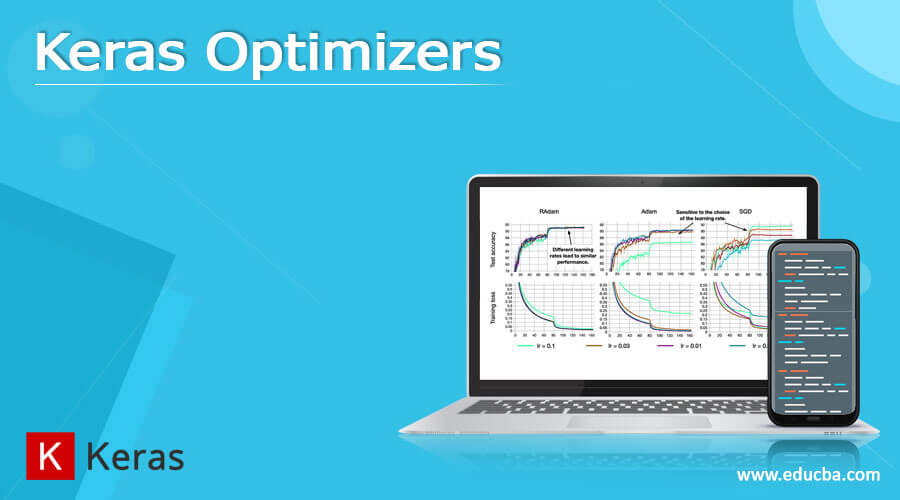Updated March 15, 2023
Introduction to Keras Optimizers
Keras Optimizers help us find a proper and optimized loss function to obtain the ideal desired weights. In this article, we will try to gain knowledge about Keras optimizers. Then, we will study the pointers like what is Keras optimizers, types of Keras optimizers, Keras optimizers models, examples, and finally, our conclusion on the same.
What are Keras Optimizers?
Optimizers are the general concept used in neural networks because it involves randomly initializing and manipulating the value of weights for every epoch to increase the model network’s accuracy potential. A comparison is made in every epoch between the output from the training data and the actual data, which helps us calculate the errors and find out the loss functions and further updation of the corresponding weights.
There needs to be some way to conclude how the weight should be manipulated to get the most accuracy for which Keras optimizers come into the picture. Keras optimizer helps us achieve the ideal weights and get a loss function that is completely optimized. One of the most popular of all optimizers is gradient descent. Various other keras optimizers are available and used widely for different practical purposes. There is a provision of various APIs provided by Keras for implementing various optimizers of Keras.
Types of Keras Optimizers
There are various types of Keras optimizers that are listed below –
- Adagrad: This optimizer of Keras uses specific parameters in the learning rates. It has got its base of the frequencies made in the updates by the value of parameters, and accordingly, the working happens. The individual features affect the learning rate and are adjusted accordingly. There is also the scenario where various values of the learning rate for some weights correspond.
- Adam: This optimizer stands for Adaptive Moment estimation. This makes the adam algorithm; the gradient descent method is upgraded for the optimization tasks. It requires less memory and is very efficient. This method must go in this scenario when we have a lot of data in bulk quantity and parameters associated with it. It is most popular among developers of neural networks.
- Nadam: This optimizer makes use of the Nadam algorithm. I stand for Nesterov and adam optimizer, and the component of Nesterov is more efficient than the previous implementations. Nesterov component is used for the updation of the gradient by the Nadam optimizer.
- Adamax: It is the adaption of the algorithm of Adam optimizer hence the name Adam max. The base of this algorithm is the infinity norm. When using the models that have embeddings, it is considered superior to Adam optimizer in some scenarios.
- RMSprop: It stands for Root mean Square propagation. The main motive of the RMSprop is to make sure that there is a constant movement in the average calculation of the square of gradients, and the performance of the task of division for gradient upon the root of average also takes place.
The syntax of using this optimizer is
Tensorflow.keras.optimizers. RMSprop(rateoflearning = 0.001, rho = 0.9, epsilon = 1e-07, momentum = 0.0, name = "RMSprop", **kwargs)- Ftrl: The version of an optimizer like this has support shrinkage type L2 and online L2 for loss function.
- SGD: This stands for the Keras Stochastic Gradient Descent Optimizer and uses momentum and gradient descent. For gradient calculations, a batched subset is used in this type of Keras optimizer.
The syntax of using the SGD type optimizer in Keras is as shown below –
Tensorflow.keras.optimizers.SGD(name= "SGD", learning_rate = 0.001, nesterov = false, momentum = 0.0, **kwargs)- Adadelta: This optimizer is used in scenarios involving adaptive learning rates concerning the gradient descent value. It helps avoid the continuous degradation of the learning rate when in the training period and helps solve the global learning rate problem.
Keras Optimizers Models
When the batch processing is finished in neural networking using the ANN model, then for the generation of prediction results, the difference between the predicted and actual value is to be calculated to decide the use of the present difference between them. Further, the model weights are adjusted on the present nodes for the networking continues for the further tasks. The algorithm used to determine this difference and appropriate weights for functionality is the optimization algorithm inside the model.
Examples of Keras Optimizers
We can use these optimizers by following either of the two ways. Firstly, we can make an optimizer instance in Keras and further use it for the method compilation. Secondly, we can directly pass the string’s required identifiers to the optimizer we use when compiling the method.
The below examples section will cover the example of using both methods for the optimizer.
Example #1
Let us consider one example of using an RMSprop optimizer –
sampleEducbaOptimizer = tensorObject.keras.sampleEducbaOptimizerimizers.RMSprop(learning_rate=0.1)
sampleEducbaVariable1= tensorObject.Variable(10.0)
calculatedLoss = lambda: (sampleEducbaVariable1** 2) / 2.0 # d(calculatedLoss) / d(sampleEducbaVariable1) = sampleEducbaVariable1
countOfSteps = sampleEducbaOptimizer.minimize(calculatedLoss, [sampleEducbaVariable1]).numpy()
sampleEducbaVariable1.numpy()Execution results in output –
Example #2
Let us consider one example for SGD optimizer implementation as the developers of neural networks most often prefer it in many of the scenarios –
import numpy as np
import tensorflow as tensorObject
sampleEducbaOptimizer = tensorObject.keras.sampleEducbaOptimizerimizers.SGD(learning_rate=0.1)
sampleVariable = tensorObject.Variable(1.0)
calculatedLoss = lambda: (sampleVariable ** 2)/2.0 # d(calculatedLoss)/d(sampleVariable1) = sampleVariable1
countOfStep = sampleEducbaOptimizer.minimize(calculatedLoss, [sampleVariable]).numpy()
# we are defining step which stands for gradient * rate of learning
sampleVariable.numpy()The output of the execution of the above program is as shown below –
Conclusion
The Keras optimizer ensures that appropriate weights and loss functions are used to keep the difference between the predicted and actual value of the neural network learning model optimized. There are various types of Keras optimizers available to choose from.
Recommended Articles
This is a guide to Keras Optimizers. Here we discuss the definition, types, models, and examples of Keras Optimizers with code implementation. You may also have a look at the following articles to learn more –



